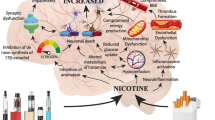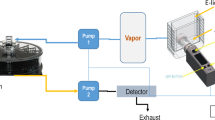Abstract
Cigarette smoking is a major prodromal factor for the onset of many adverse health effects that may occur in the short run and is the leading cause of preventable disease, disability, and death in the United States. Moreover, it is well established that chronic smoking is associated with vascular endothelial dysfunction in a causative and dose-dependent manner primarily related to the release of reactive oxygen species (ROS), nicotine, and the induction of oxidative stress (OS)-driven inflammation. Preclinical studies have also shown that nicotine (the principal e-liquid ingredient used in e-cigarettes) can also cause OS, exacerbating cerebral ischemia and secondary brain injury. Likewise, chronic e-Cig va** could be prodromal to cerebrovascular impairment and promote cerebrovascular conditions favoring stroke onset and worsening post-ischemic brain injury. Therefore, using mouse models is crucial to understand how xenobiotics such as those released by conventional and/or e-cigs can impact the onset and severity of stroke as well as post-stroke recovery. To appropriately model human-like smoking/va** behavior in mice, however, the exposure to these xenobiotics must be standardized and undertaken in a controlled environment. This chapter describes a well-validated protocol to reproduce standardized chronic tobacco smoke or e-cigarette vape exposure in mice in the setting of a mouse transient ischemic stroke model.
Access this chapter
Tax calculation will be finalised at checkout
Purchases are for personal use only
Similar content being viewed by others
References
Chen J, Li S, Zheng K et al (2019) Impact of smoking status on stroke recurrence. J Am Heart Assoc 8:e011696
Coresta (1991) Routine analytical cigarette-smoking machine: speciications, definitions, and standard conditions. Recommended methods 22
Duncan MS, Freiberg MS, Greevy RA Jr et al (2019) Association of smoking cessation with subsequent risk of cardiovascular disease. JAMA 322:642–650
Ftc (1997) Cigarette testing; request for public comment; notice. In: Commission FT (ed) Federal register
Gentzke AS, Wang TW, Cornelius M et al (2022) Tobacco product use and associated factors among middle and high school students – National Youth Tobacco Survey, United States, 2021. MMWR Surveill Summ 71:1–29
Hossain M, Sathe T, Fazio V et al (2009) Tobacco smoke: a critical etiological factor for vascular impairment at the blood-brain barrier. Brain Res 1287:192–205
Kaisar MA, Kallem RR, Sajja RK et al (2017) A convenient UHPLC-MS/MS method for routine monitoring of plasma and brain levels of nicotine and cotinine as a tool to validate newly developed preclinical smoking model in mouse. BMC Neurosci 18:71
Kaisar MA, Villalba H, Prasad S et al (2017) Offsetting the impact of smoking and e-cigarette va** on the cerebrovascular system and stroke injury: is metformin a viable countermeasure? Redox Biol 13:353–362
Klein AP, Yarbrough K, Cole JW (2021) Stroke, smoking and va**: the no-good, the bad and the ugly. Ann Public Health Res 8:1104
Krishnan-Sarin S, Jackson A, Morean M et al (2019) E-cigarette devices used by high-school youth. Drug Alcohol Depend 194:395–400
Lee J, Taneja V, Vassallo R (2012) Cigarette smoking and inflammation: cellular and molecular mechanisms. J Dent Res 91:142–149
Naik P, Fofaria N, Prasad S et al (2014) Oxidative and pro-inflammatory impact of regular and denicotinized cigarettes on blood brain barrier endothelial cells: is smoking reduced or nicotine-free products really safe? BMC Neurosci 15:51
Naik P, Sajja RK, Prasad S et al (2015) Effect of full flavor and denicotinized cigarettes exposure on the brain microvascular endothelium: a microarray-based gene expression study using a human immortalized BBB endothelial cell line. BMC Neurosci 16:38
Pan B, ** X, Jun L et al (2019) The relationship between smoking and stroke: a meta-analysis. Medicine (Baltimore) 98:e14872
Peters SA, Huxley RR, Woodward M (2013) Smoking as a risk factor for stroke in women compared with men: a systematic review and meta-analysis of 81 cohorts, including 3,980,359 individuals and 42,401 strokes. Stroke 44:2821–2828
Shah RS, Cole JW (2010) Smoking and stroke: the more you smoke the more you stroke. Expert Rev Cardiovasc Ther 8:917–932
Yanbaeva DG, Dentener MA, Creutzberg EC et al (2007) Systemic effects of smoking. Chest 131:1557–1566
Zhao J, Qiao L, Shang P et al (2021) Effects of smokeless tobacco on cell viability, reactive oxygen species, apoptosis, and inflammatory cytokines in human umbilical vein endothelial cells. Toxicol Mech Methods 31:349–358
Acknowledgments
This work was supported by the National Institutes of Health/National Institute on Drug Abuse 2R01-DA029121 and 1R01-DA049737 and the National Institute of Neurological Disorders and Stroke 1R01NS117906 to Dr. Luca Cucullo.
Author information
Authors and Affiliations
Corresponding author
Editor information
Editors and Affiliations
Rights and permissions
Copyright information
© 2023 The Author(s), under exclusive license to Springer Science+Business Media, LLC, part of Springer Nature
About this protocol
Cite this protocol
Mancuso, S., Bhalerao, A., Cucullo, L. (2023). Use of Conventional Cigarette Smoking and E-Cigarette Va** for Experimental Stroke Studies in Mice. In: Karamyan, V.T., Stowe, A.M. (eds) Neural Repair. Methods in Molecular Biology, vol 2616. Humana, New York, NY. https://doi.org/10.1007/978-1-0716-2926-0_31
Download citation
DOI: https://doi.org/10.1007/978-1-0716-2926-0_31
Published:
Publisher Name: Humana, New York, NY
Print ISBN: 978-1-0716-2925-3
Online ISBN: 978-1-0716-2926-0
eBook Packages: Springer Protocols




